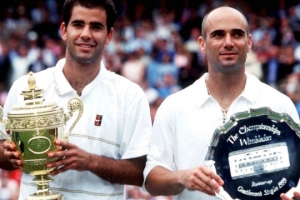One of the big questions that arises every year at the US Open is: Who will be the next standard bearer for Men's tennis from the USA. The US has been pushed to a second tier by the extraordinary successes of Nadal, Djokovic and Federrer for the past 5-6 years. US tennis fans once complained about Pete Sampras and how he was "colorless"-but those same fans now yearn for any homegrown talent to fill this void.
It is an interesting question as to why the US is suffering this drought. Obviously, great athletes in the US have many choices. Basketball, baseball, football, soccer, lacrosse and golf all have different appeals, and at the same time, tennis has shrunk from its peak in appeal of 20 years ago to its current state. There are many worthwhile programs now promoting the next generation of stars, but so far we have not seen who is the next signature player.
What makes a #1 player? Obviously, it requires a superior athlete with the means to avail themselves of top flight coaching and management. But, the legendary Williams sisters were truly home schooled in tennis and have reached unprecedented levels in the women's arena.
A look back into time can provide some perspectives.
In the past, tennis began as a baseline game, in no small part related to the fact that the tiny sweet spot on wooden rackets made volleying extremely difficult. But, oh boy, when a volleyer came on the scene, it was a seismic change at the higher levels of competition. When engineering perfected large and mid-sized rackets, the volley was achievable by all players.
Once everyone could volley, the biggest criterion was actually related to the surfaces. Red clay is almost a different sport and favors European players. Grass became the domain of Brits and Aussies. The US evolved from har-tru to hardcourts a generation ago, and as a result a specific style of tennis evolved.
There have been three quasi-schools of play: serve and volley, baseline and "all-court". These styles are personified by Federer (serve and volley), Nadal (Baseline master) and Djokovic (all court) ---effectively demonstrating that dominance can still be achieved with any style provided that the coaching and surfaces are aligned for any particular emerging star.
Despite these apparent differentiations, the hard lines are blurred to a great extent. All great players "can" play in any style even if they have preferences. Federer is a successor to a Sampras, an Edberg, an Ashe and so on in the serve and volley style. Nadal is a successor to a Jimmy Connors, Ivan Lendl and so on. Djokovic is a successor to McEnroe who in turn was a successor to Rod Laver and so on as all court players. Today these players have essentially no weaknesses and unbelievable endurance as well as indomitable drives to win even in the fifth hour of a grueling five set match.
So what other subtleties can we see that influenced trends? Well there have been players renowned for extraordinary returns of serve (Rosewall, Connors for two). Others dominated from unusual strokes-such as Agassi who could stand in "no man's land" and thunder ground strokes at chin level. Today there is a US player with a huge first serve in the style of Rosco Tanner and Colin Dibley but, a huge serve by itself cannot dominate when the players today are all so good.
If this was a management problem or an economic problem, theorists would have a blithering array of hypothetical reasons (even beyond genetic engineering). So, let's play that role. The US features a predominance of hard courts (with a smattering of har-tru for smarter seniors who do not want to destroy what is left of their knees, hips and backs). The US has a deep pool of fabulous athletes, fabulous coaches, training facilities and even sponsors-but, do we have a specific strategy? I submit that we also have a genetic reality that on average, the height of the American male is somewhat taller than other countries.
If we add these factors together and allow them to step in our opinionated selves, it may well be that the strategy would be to apply the science available here (diet, kinesiology, training and so on) to the athletes (tall, rangy, fit) to a style of play-and that style of play is the return to the serve and volley but with all court play as a "given". We should no longer see dozens of aspiring stars standing five feet behind the baselines hitting fierce top spin as if that is the sole secret to tennis. We need a dominating presence (such as a John McEnroe) to be a standard bearer for this return to the tennis that he practiced at such a high level.
Who will be the next standard bearer for Men's tennis from the USA?

















